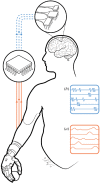Biological and bionic hands: natural neural coding and artificial perception
- PMID: 26240424
- PMCID: PMC4528821
- DOI: 10.1098/rstb.2014.0209
Biological and bionic hands: natural neural coding and artificial perception
Abstract
The first decade and a half of the twenty-first century brought about two major innovations in neuroprosthetics: the development of anthropomorphic robotic limbs that replicate much of the function of a native human arm and the refinement of algorithms that decode intended movements from brain activity. However, skilled manipulation of objects requires somatosensory feedback, for which vision is a poor substitute. For upper-limb neuroprostheses to be clinically viable, they must therefore provide for the restoration of touch and proprioception. In this review, I discuss efforts to elicit meaningful tactile sensations through stimulation of neurons in somatosensory cortex. I focus on biomimetic approaches to sensory restoration, which leverage our current understanding about how information about grasped objects is encoded in the brain of intact individuals. I argue that not only can sensory neuroscience inform the development of sensory neuroprostheses, but also that the converse is true: stimulating the brain offers an exceptional opportunity to causally interrogate neural circuits and test hypotheses about natural neural coding.
Keywords: biomimicry; neuroprosthetics; proprioception; somatosensory cortex; touch.
Figures



References
-
- Johannes MS, Bigelow JD, Burck JM, Harshbarger SD, Kozlowski MV, Van Doren T. 2011. An overview of the developmental process for the Modular Prosthetic Limb. The Johns Hopkins University Applied Physics Laboratory Technical Digest 30, 207–216.
-
- Ghez C, Gordon J, Ghilardi FM, Sainburg R. 1995. Contributions of vision and proprioception to accuracy in limb movements. In The Cognitive neurosciences (ed. Gazzaniga MS.), pp. 549–564. Cambridge, MA: The MIT Press.
Publication types
MeSH terms
LinkOut - more resources
Full Text Sources
Other Literature Sources
Medical

